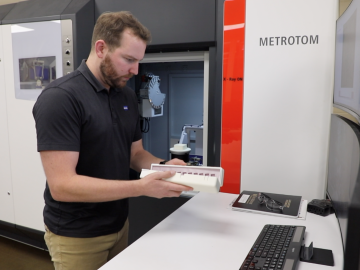
Filter News
Area of Research
- (-) Energy Science (153)
- (-) Nuclear Science and Technology (16)
- (-) Supercomputing (117)
- Advanced Manufacturing (24)
- Biology and Environment (55)
- Building Technologies (3)
- Computational Biology (1)
- Computational Engineering (3)
- Computer Science (16)
- Electricity and Smart Grid (1)
- Energy Sciences (1)
- Functional Materials for Energy (1)
- Fusion and Fission (8)
- Fusion Energy (3)
- Isotope Development and Production (1)
- Isotopes (4)
- Materials (66)
- Materials for Computing (16)
- Mathematics (1)
- National Security (28)
- Neutron Science (25)
- Quantum information Science (7)
News Topics
- (-) 3-D Printing/Advanced Manufacturing (83)
- (-) Artificial Intelligence (42)
- (-) Computer Science (109)
- (-) Molten Salt (5)
- (-) Polymers (13)
- (-) Space Exploration (10)
- Advanced Reactors (16)
- Big Data (27)
- Bioenergy (29)
- Biology (19)
- Biomedical (24)
- Biotechnology (6)
- Buildings (39)
- Chemical Sciences (16)
- Clean Water (8)
- Composites (17)
- Coronavirus (25)
- Critical Materials (12)
- Cybersecurity (15)
- Energy Storage (74)
- Environment (69)
- Exascale Computing (27)
- Fossil Energy (2)
- Frontier (32)
- Fusion (10)
- Grid (41)
- High-Performance Computing (44)
- Hydropower (3)
- Isotopes (7)
- Machine Learning (20)
- Materials (45)
- Materials Science (43)
- Mathematics (4)
- Mercury (3)
- Microelectronics (1)
- Microscopy (14)
- Nanotechnology (15)
- National Security (11)
- Neutron Science (23)
- Nuclear Energy (44)
- Partnerships (12)
- Physics (10)
- Quantum Computing (20)
- Quantum Science (26)
- Security (10)
- Simulation (18)
- Software (1)
- Statistics (1)
- Summit (44)
- Transportation (70)
Media Contacts

The presence of minerals called ash in plants makes little difference to the fitness of new naturally derived compound materials designed for additive manufacturing, an Oak Ridge National Laboratory-led team found.

Oak Ridge National Laboratory scientists designed a recyclable polymer for carbon-fiber composites to enable circular manufacturing of parts that boost energy efficiency in automotive, wind power and aerospace applications.

As the United States shifts away from fossil-fuel-burning cars and trucks, scientists at the Department of Energy’s Oak Ridge and Argonne national laboratories are exploring options for another form of transportation: trains. The research focuses on zero-carbon hydrogen and other low-carbon fuels as viable alternatives to diesel for the rail industry.

Laboratory Director Thomas Zacharia presented five Director’s Awards during Saturday night's annual Awards Night event hosted by UT-Battelle, which manages ORNL for the Department of Energy.

A new deep-learning framework developed at ORNL is speeding up the process of inspecting additively manufactured metal parts using X-ray computed tomography, or CT, while increasing the accuracy of the results. The reduced costs for time, labor, maintenance and energy are expected to accelerate expansion of additive manufacturing, or 3D printing.

Researchers at ORNL have developed an online tool that offers industrial plants an easier way to track and download information about their energy footprint and carbon emissions.

Researchers at ORNL recently demonstrated a new technology to better control how power flows to and from commercial buildings equipped with solar, wind or other renewable energy generation.

Two years after ORNL provided a model of nearly every building in America, commercial partners are using the tool for tasks ranging from designing energy-efficient buildings and cities to linking energy efficiency to real estate value and risk.

A multi-lab research team led by ORNL's Paul Kent is developing a computer application called QMCPACK to enable precise and reliable predictions of the fundamental properties of materials critical in energy research.

ORNL has been selected to lead an Energy Frontier Research Center, or EFRC, focused on polymer electrolytes for next-generation energy storage devices such as fuel cells and solid-state electric vehicle batteries.


